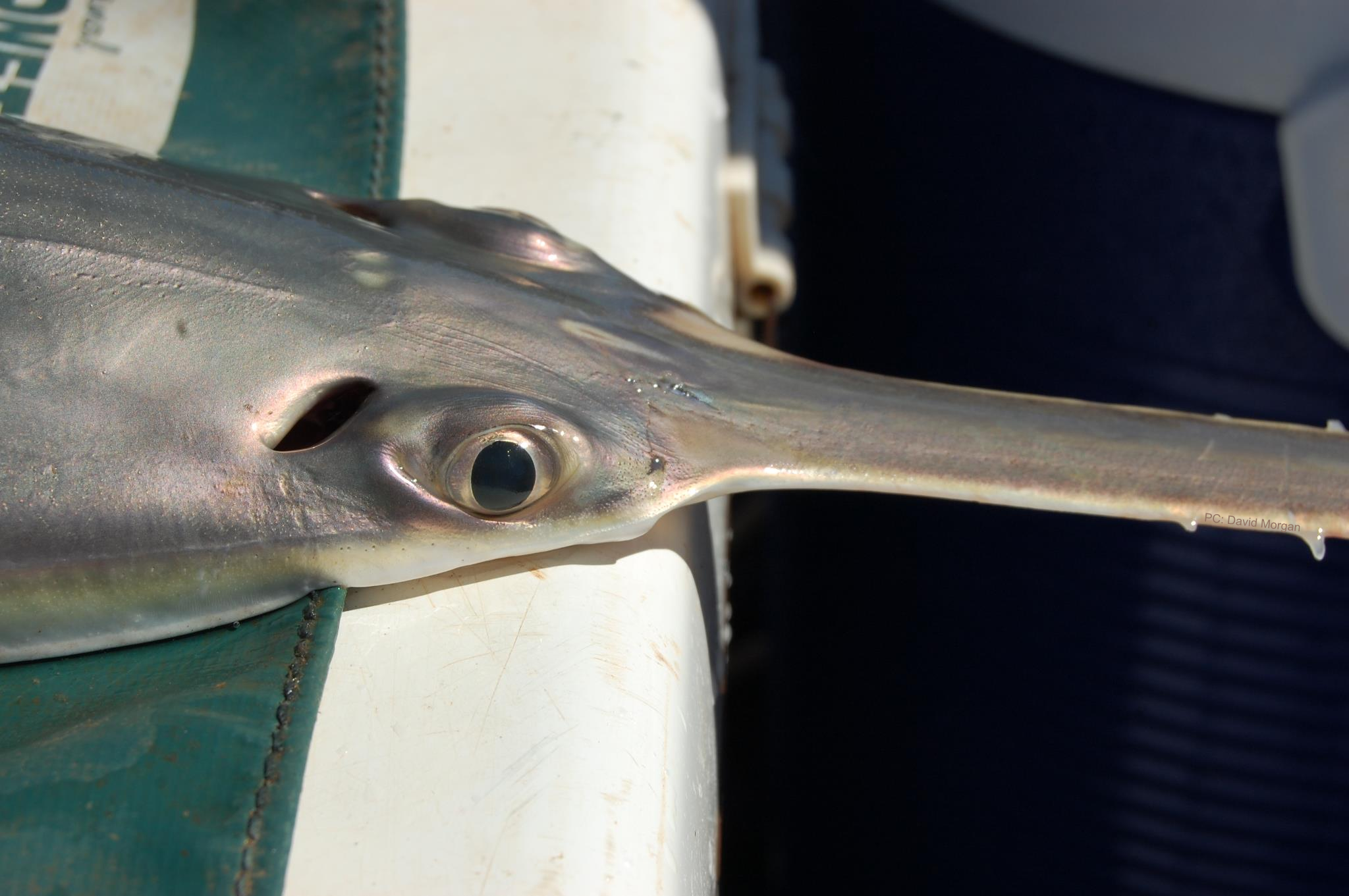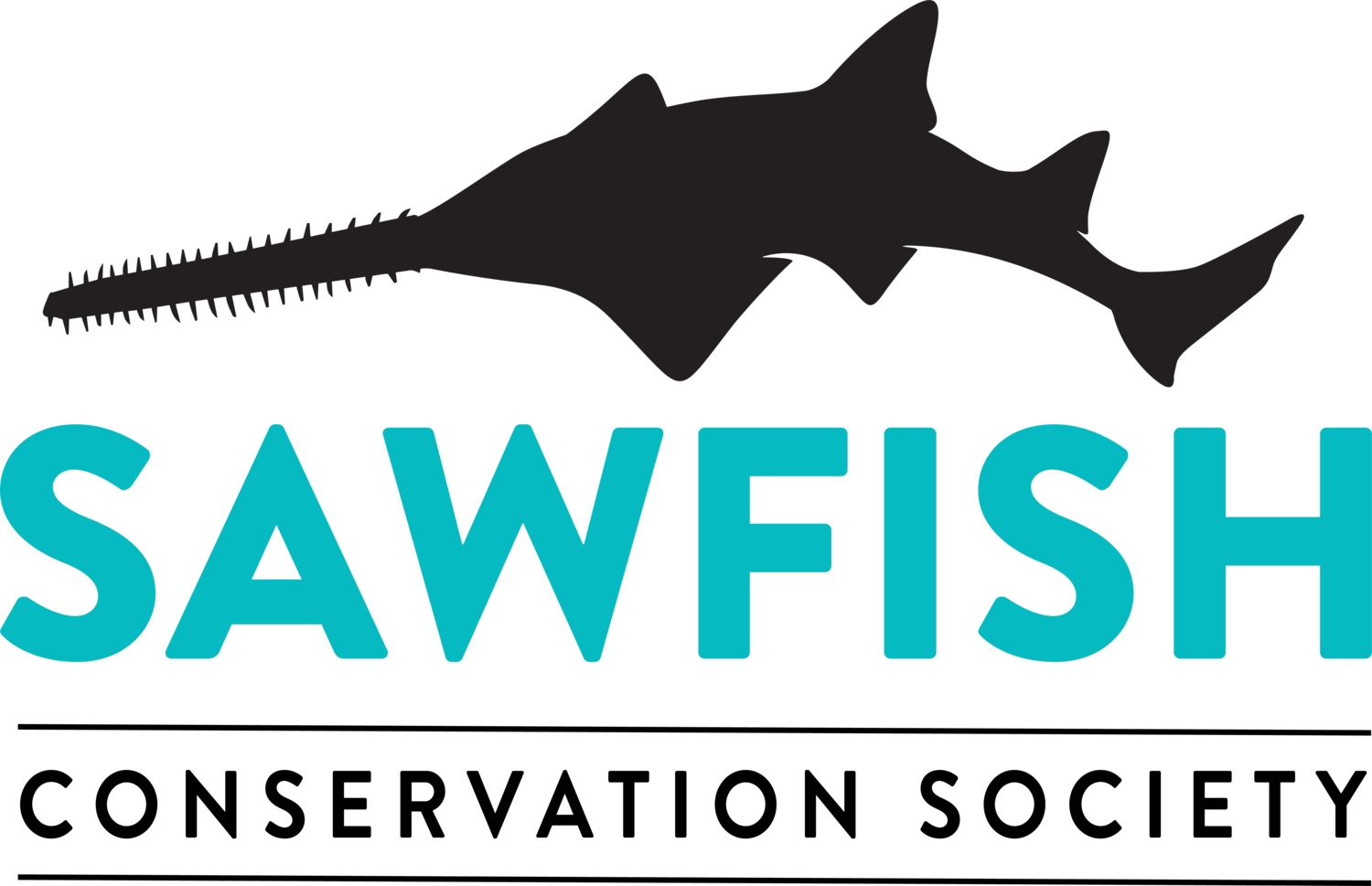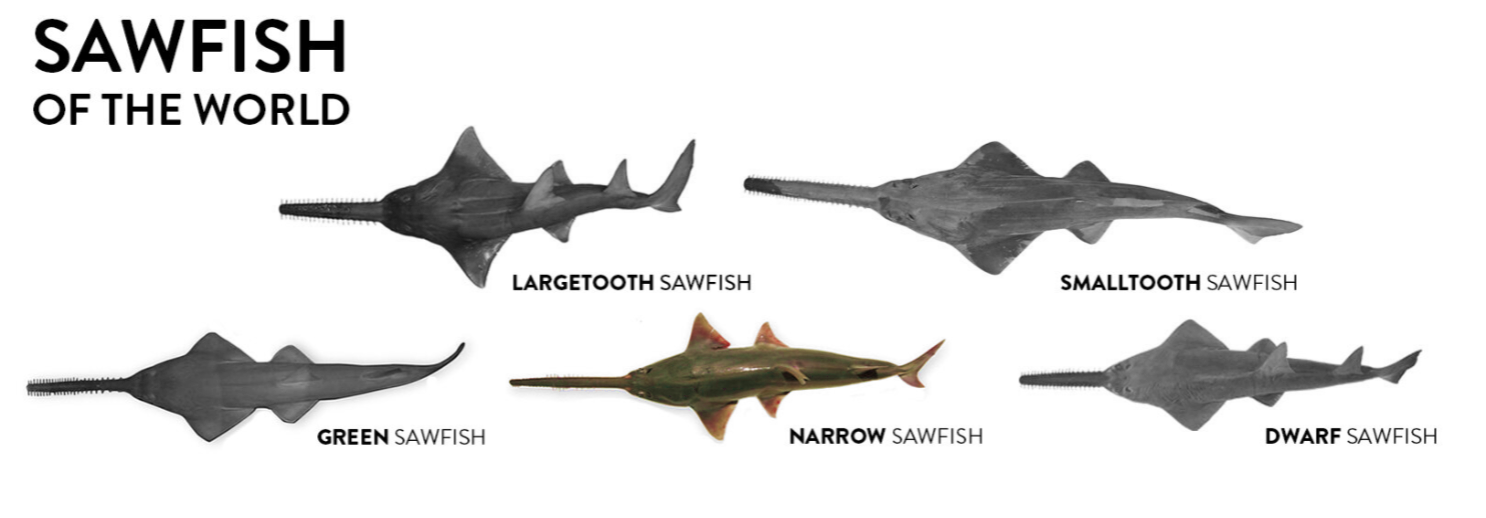
NARROW SAWFISH Anoxypristis cuspidata
IUCN status: ENDANGERED
The narrow (or knifetooth) sawfish (Anoxypristis cuspidata) reaches a maximum total length (TL) of at least 350 cm (11.5 feet). This sawfish lives in nearshore and offshore habitats in the Indo-West Pacific (Red Sea to Australia and north to South Korea). The narrow sawfish is the most distinct sawfish. It can be best identified by: a lack of rostral teeth near the start of its rostrum (i.e. saw), a relatively large lower caudal (i.e. tail) fin and the start of its first dorsal (i.e. top) fin being behind that of its pelvic fins. The knifetooth sawfish has 16-33 rostral teeth per side. See below for detailed information.
SIZE: 70 to 470 cm (2 to 15.5 feet) total length
DISTRIBUTION: Indo-West Pacific
IDENTIFICATION: Start of first dorsal (top) fin behind start of pelvic (lower, back) fins, distinct lower caudal (tail) fin lobe, relatively small triangular pectoral fins. Rostrum is relatively narrow with no rostral teeth on bottom fourth of rostrum.
NARROW SAWFISH DESCRIPTION
Size: Pupped at around 43-70 cm total length (Compagno and Last 1999, Last and Stevens 2009). Estimations of maximum total length ranging between 350-470 cm (Compagno and Last 1999, Peverell 2008, Last and Stevens 2009).
Fin position/markings: Relatively small and triangular pectoral fins (Compagno and Last 1999, Last and Stevens 2009). Lower lobe of caudal fin easily identifiable (Last and Stevens 2009). Origin of first dorsal fin posterior to that of the pelvic fin (Compagno and Last 1999, Last and Stevens 2009). Lacks an anal fin. No discernable markings on fins.
Rostral morphology and meristics: Relatively narrow rostrum, with standard rostrum width ranging from 8-15% of standard rostrum length (Whitty et al. in press). Standard rostrum length and total rostrum length range from 9-39% and 12-41% of total length, respectively (Whitty et al. in press).
Anoxypristis cuspidata has 16-33 rostral teeth per side (Compagno and Last 1999, Last and Stevens 2009, Faria et al. 2012, Whitty et al. in press), although the number of rostral teeth per side vary between 0 and 4 (Compagno and Last 1999, Faria et al. 2012, Whitty et al. in press). Counts also differ between regions and possibly between sex (Compagno and Last 1999). Rostral teeth are relatively flat, short and spade or hooked shaped, unlike the awl shape observed in other sawfishes (Miller 1974, Last and Stevens 2009, Faria et al. 2012, Whitty et al. in press). No posterior groove on rostral teeth (Miller 1974, Compagno and Last 1999, Whitty et al. in press). The most distal rostral tooth gap is 11-44% that of the most proximal rostral tooth gap (Compagno and Last 1999, Whitty et al. in press).
Dermal denticles: Sparsely distributed tricuspidate dermal denticles on dorsal and ventral surfaces (Deynat 2005). Lacks dermal denticles in buccopharyngeal cavity (Deynat 2005). Dermal denticles most concentrated on anterior regions of head and fins (Deynat 2005). Number of dermal denticles increases with size, with no denticles observerd on individuals <64 cm total length (Deynat 2005).
Vertebral Count: Undocumented
NARROW SAWFISH HABITAT
Distribution: Recorded in West Pacific (northern Australia to South Korea) through southern Asia to the Red Sea (Compagno and Last 1999, Peverell 2005, Last and Stevens 2009, D'Anastasi 2010, Morgan et al. 2011, Faria et al. 2012). Map available at www.iucnredlist.org. Provided map not complete. Distribution in Australia extends from Karratha on the central Western Australian coast, north, around to Rockhampton on the central Queensland coast.
Habitat: Inhabits nearshore estuarine (juveniles and pupping females) and offshore marine (adults) waters (Peverell 2005). Oberved in depths of >100 m (Last and Stevens 2009, D'Anastasi 2010).
NARROW SAWFISH LIFE HISTORY
Age and growth: Anoxypristis cuspidata were observed to be age 0+ at 83-115 cm, 1+ at 118-164 cm, 2+ at 182-247 cm, 3+ at 227-302 cm, 4+ at 298-300 cm and 5+ at 316-338 cm total length (Peverell 2008). Peverell reported a k-value of 0.34 per year (Linfin = 377 cm, t0 = -0.53) (Peverell 2008). Asymptotic growth was reached at 9 years (389 cm TL).
Reproduction: Aplacental viviparity (lecithotropic nutrition) (Peverell 2008, Last and Stevens 2009). Litter sizes are an average of 12 pups and a maximum of 16 pups (Last and Stevens 2009, D'Anastasi 2010). Genetic data on four litters indicates that A. cuspidata only have one father per litter, which is in contrast to all other sharks and rays studied to date (D'Anastasi 2010).
Maturity: Peverell (2008) suggested that sexual maturity is reached at a size of around 203 cm total length and an age of 2+ years in males, and 225 cm total length and an age of 3+ years in females. Last and Stevens (2009) reported that sexual maturity is reached at and age of 4 years for males and 5 years for females.
NARROW SAWFISH DIET
Diet is largely unknown. However, A. cuspidata has been observed to have consumed cuttlefish, squid and various small teleosts (Compagno and Last 1999, Peverell 2008).
NARROW SAWFISH POPULATION GENETICS
Anoxypristis cuspidata populations in northern Australia form distinct stocks on the western and eastern coasts of Australia. The Gulf of Carpentaria may also represent a distinct stock, but with some gene flow to and from the western and eastern coasts (based on mitochondrial DNA only) (D'Anastasi 2010). The genetic diversity of these populations ranges from extremely low to moderate, with extremely low diversity on the eastern coast of Australia (D'Anastasi 2010).
NARROW SAWFISH STATUS
Population estimates are unknown. However, evidence suggests a decline in the numbers and range of Pristis spp. in Australia (Stevens et al. 2005, White and Kyne 2010). Anoxypristis cuspidata make up the largest portion of sawfish caught by commerical net-fisheries (McAuley et al. 2005, Peverell 2005, Field et al. 2008, Harry et al. 2011).
Anoxypristis cuspidata is listed as Endangered on the IUCN redlist (IUCN 2013). This species is listed on Appendix I by CITES, not allowing international trade. Anoxypristis cuspidata is listed under Schedule I on the Wildlife Protection Act in India. This species is not listed on the EPBC Act in Australia (i.e. no protection provided in federal water) but is protected in state waters in Western Australia and Queensland.
COMPOSED BY JEFF WHITTY, BLANCHE D'ANASTASI and NICOLE PHILLIPS

